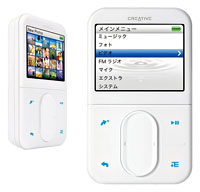 Creative Zen Vision:M
Creative Zen Vision:M
Although looking like a near-exact copy of the video iPod, the 30 gig Zen Vision is a fine player in its own right, sporting persuasive features not found on its rival.
Sharing near-identical physical dimensions as the iPod, the Zen manages to add a composite video out connector for playing video content on TVs, an integrated FM radio with 32 presets, voice recording, alarm clock, groovy customisable themes and the ability to synchronise Microsoft Outlook data, such as contacts, calendar and tasks.
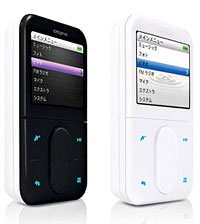 The player’s a versatile chap too, with the Vision:M outgunning the iPod by supporting a wider range of formats, like MP3, WMA and PlaysForSure audio formats and MPEG1/2/4, DivX and XviD, Motion JPEG and WMV for video.
The player’s a versatile chap too, with the Vision:M outgunning the iPod by supporting a wider range of formats, like MP3, WMA and PlaysForSure audio formats and MPEG1/2/4, DivX and XviD, Motion JPEG and WMV for video.
Battery life is claimed at four hours in video-playback mode (twice as long as the iPod) and fourteen hours for audio.
Expected on the streets now, the Creative Zen Vision:M will sell for around $350 (~£197, ~€291).
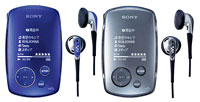 Sony NW-A1000
Sony NW-A1000
It’s taken Sony a long time to come up with a serious challenge to iPod’s dominance, but the new NW-A1000 could be the one to unseat the Nano.
Resplendent in an unusual organic form factor, the player sports a translucent acrylic clad exterior that reveals a large, bright display lurking below. It looks fantastic, and it’s refreshing to see a radical new design coming through in a market dominated by iPod-alikes.
 The palm sized player (88 x 55 x 19 mm) comes with a built in 6GB hard drive and supports MP3 files as well as Sony’s ATRAC3 and ATRAC3+ audio formats. Battery life is claimed at 20 hours (although several reviews have found that figure to be wildly optimistic).
The palm sized player (88 x 55 x 19 mm) comes with a built in 6GB hard drive and supports MP3 files as well as Sony’s ATRAC3 and ATRAC3+ audio formats. Battery life is claimed at 20 hours (although several reviews have found that figure to be wildly optimistic).
Thankfully, Sony have finally ditched the awful Sonic Stage software needed to transfer files over the USB 2.0 connection, but the new Connect Player software still has some way to go to match the simplicity and ease of use of iTunes.
The player’s already available in Europe and North America, priced around €250 and $250.
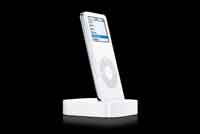 Apple iPod Nano
Apple iPod Nano
Introduced in September, Apple’s fabulously designed iPod Nano has already proved an enormous hit, with its teensy-weensy dimensions and stunning looks crushing every flash-based player in sight.
Sure, it’s not perfect – there’s no video support and the thing scratches easier than a Shakin’ Stevens 45 – but it features Apple’s superb Click Wheel user interface and offers a crisp 1.5″ colour screen for viewing photos.
Coming in 2GB and 4GB flavours, the diminutive player (3.3 x 0.98 x 0.33 inches) supports MP3, AAC and Audible 2, 3 and 4 formats and is compatible with the iTunes online store.
Microsoft Outlook calendar and contacts info can be synchronised via iTunes 5, and with the player sporting the same 30-pin dock connector as the iPod and iPod mini, there should be no shortage of accessories.
There’s a nippy USB 2.0 port onboard and battery life is claimed at a healthy 14 hours.
Starting at €200 (~$240 ~£135), the Nano is available in just black or white for now.
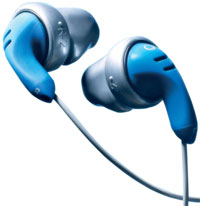 In-ear headphones (“earbuds”) like those sold with the iPod and other music players can increase the risk of hearing loss, according to a US audiologist (a what?!)
In-ear headphones (“earbuds”) like those sold with the iPod and other music players can increase the risk of hearing loss, according to a US audiologist (a what?!) We can certainly verify that some folks seem oblivious to the risk, blasting their music so high that we can hear the annoying “tssk chk tssk chk” leaking from in-ear phones over the thunderous rattle of a tube train.
We can certainly verify that some folks seem oblivious to the risk, blasting their music so high that we can hear the annoying “tssk chk tssk chk” leaking from in-ear phones over the thunderous rattle of a tube train. Garstecki proposes the 60%/60 minute rule as a solution – this involves listening to an MP3 device for no longer than about an hour a day and at levels below 60% of maximum volume.
Garstecki proposes the 60%/60 minute rule as a solution – this involves listening to an MP3 device for no longer than about an hour a day and at levels below 60% of maximum volume.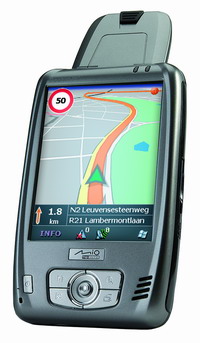 Out just in time for overgrown boys to stick it on their Santa wish list, Mio Technology have announced their new Mio A201 integrated GPS model.
Out just in time for overgrown boys to stick it on their Santa wish list, Mio Technology have announced their new Mio A201 integrated GPS model. Mio are promoting the device as a ‘go anywhere’ portable sat-nav device which can be used for drivers, mountain bikes or walkers ambling through the countryside.
Mio are promoting the device as a ‘go anywhere’ portable sat-nav device which can be used for drivers, mountain bikes or walkers ambling through the countryside.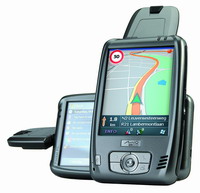 There’s the usual Outlook synchronisation options available, and we rather liked the new Compass Mode designed for navigating off road on foot or on a bicycle.
There’s the usual Outlook synchronisation options available, and we rather liked the new Compass Mode designed for navigating off road on foot or on a bicycle.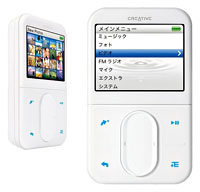 Creative are set to take on Apple’s video-enabled fifth-generation iPod with their new Zen Vision:M player, due to be announced tomorrow.
Creative are set to take on Apple’s video-enabled fifth-generation iPod with their new Zen Vision:M player, due to be announced tomorrow.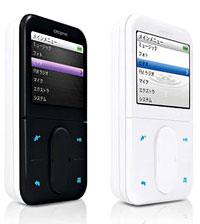 Creative claim that the rechargeable battery can keep punters entertained for four hours in video-playback mode – twice as long as the iPod’s two hours.
Creative claim that the rechargeable battery can keep punters entertained for four hours in video-playback mode – twice as long as the iPod’s two hours. It’s a shame seeing a company as, err, creative as Creative coming up with a design so obviously ‘inspired’ by the iPod, but perhaps it’s a sign that they’re signing up to a philosophy of, “if you can’t beat them, join them.”
It’s a shame seeing a company as, err, creative as Creative coming up with a design so obviously ‘inspired’ by the iPod, but perhaps it’s a sign that they’re signing up to a philosophy of, “if you can’t beat them, join them.”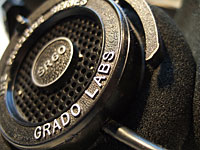 They may look like something a WW2 pilot would have strapped on to their heads before going off for a dogfight, but the Grado SR60s are, quite simply, the best headphones in their price bracket – and higher.
They may look like something a WW2 pilot would have strapped on to their heads before going off for a dogfight, but the Grado SR60s are, quite simply, the best headphones in their price bracket – and higher.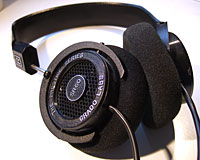 Untroubled by the vagaries of fashion, Grado’s hand-made SR60s have a refreshing no-nonsense look about them.
Untroubled by the vagaries of fashion, Grado’s hand-made SR60s have a refreshing no-nonsense look about them. The driver units are covered by black supra-aural foam ear pads, with an unusually thick cable coming from each earpiece, stethoscope-style.
The driver units are covered by black supra-aural foam ear pads, with an unusually thick cable coming from each earpiece, stethoscope-style.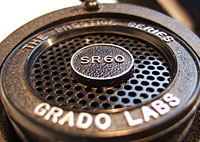 Sonically, they’re a revelation. The sound is full-bodied, fast and articulate with a solid bass performance creating an impressively spacious soundstage.
Sonically, they’re a revelation. The sound is full-bodied, fast and articulate with a solid bass performance creating an impressively spacious soundstage.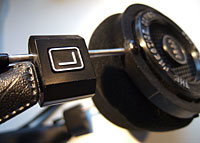 The clarity and depth of these phones is unheard of at this price level – stick on a pair of trendy designer “DJ” headphones after a session on the Grados and it’ll sound like listening to a transistor radio.
The clarity and depth of these phones is unheard of at this price level – stick on a pair of trendy designer “DJ” headphones after a session on the Grados and it’ll sound like listening to a transistor radio. Despite our catastrophic experiences with the
Despite our catastrophic experiences with the 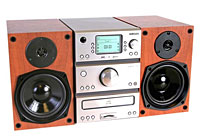 Context-sensitive buttons either side of the display provide a simple user interface offering fast access to relevant features – it’s one of the best interfaces we’ve seen.
Context-sensitive buttons either side of the display provide a simple user interface offering fast access to relevant features – it’s one of the best interfaces we’ve seen. A unique feature to Pure is the ReVu function, which lets you pause and ‘rewind’ live DAB digital radio, courtesy of a constantly updating 20 minute buffer.
A unique feature to Pure is the ReVu function, which lets you pause and ‘rewind’ live DAB digital radio, courtesy of a constantly updating 20 minute buffer. The package is rounded off by two stylish Rosewood speakers with 5¼” woofers, and 19mm Mylar-dome tweeters, a simple remote control and aerial.
The package is rounded off by two stylish Rosewood speakers with 5¼” woofers, and 19mm Mylar-dome tweeters, a simple remote control and aerial. LG Electronics’ PR department clearly don’t believe in a day of rest because Sunday saw them busily announcing the impending release of their LG PM 80, a PDA capable of receiving T-DMB (terrestrial digital multimedia broadcasting).
LG Electronics’ PR department clearly don’t believe in a day of rest because Sunday saw them busily announcing the impending release of their LG PM 80, a PDA capable of receiving T-DMB (terrestrial digital multimedia broadcasting). The actual device, presented here in the traditional manner by near-ecstatic Korean ladies (if only we got so much unbridled joy from our gadgets) follows the traditional PDA form factor, with the addition of an old-school pull out aerial for TV reception.
The actual device, presented here in the traditional manner by near-ecstatic Korean ladies (if only we got so much unbridled joy from our gadgets) follows the traditional PDA form factor, with the addition of an old-school pull out aerial for TV reception. As ever, the Koreans will get to play with this device for ages before we even get a peek at it – if they don’t decide to keep it to themselves for ever, of course.
As ever, the Koreans will get to play with this device for ages before we even get a peek at it – if they don’t decide to keep it to themselves for ever, of course. Nielsen, the top American agency that measures TV viewing audiences, is going to provide ratings that take account of time-shifted viewing through digital recording devices like TiVos even though viewers are able to, and in my experience, generally do, fast-forward through the paid for messages.
Nielsen, the top American agency that measures TV viewing audiences, is going to provide ratings that take account of time-shifted viewing through digital recording devices like TiVos even though viewers are able to, and in my experience, generally do, fast-forward through the paid for messages.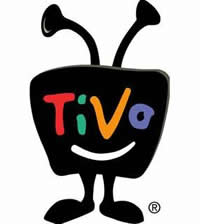 The US networks say that time-shifted ratings should be taken into account, and point out that PVR users watch more TV – which we don’t dispute. They watch around 5.7 hours and that’s more than 10% extra when compared with the technologically-disadvantaged standard household. Their logic follows that this extra 10% of viewing, gives them more opportunity to see commercials. With PVR penetration in the USA already around 8% of the TV universe and expected to rise steadily over the coming years, this adds up to a is significant amount for media buyers.
The US networks say that time-shifted ratings should be taken into account, and point out that PVR users watch more TV – which we don’t dispute. They watch around 5.7 hours and that’s more than 10% extra when compared with the technologically-disadvantaged standard household. Their logic follows that this extra 10% of viewing, gives them more opportunity to see commercials. With PVR penetration in the USA already around 8% of the TV universe and expected to rise steadily over the coming years, this adds up to a is significant amount for media buyers. Hauppauge Digital have whipped out a new add-on card to convert a boring old PC into a multimedia-tastic satellite TV receiver.
Hauppauge Digital have whipped out a new add-on card to convert a boring old PC into a multimedia-tastic satellite TV receiver.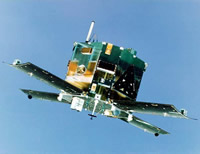 Freesat will be the satellite equivalent of Freeview,” said Yehia Oweiss, Managing Director of Hauppauge Digital. “Already broadcasting BBC, the service will be available to all UK households and bring free digital TV to the 25 per cent who are outside Freeview’s area. Consumers can buy our Freesat tuner now and enjoy many digital channels now, with more being added all the time.”
Freesat will be the satellite equivalent of Freeview,” said Yehia Oweiss, Managing Director of Hauppauge Digital. “Already broadcasting BBC, the service will be available to all UK households and bring free digital TV to the 25 per cent who are outside Freeview’s area. Consumers can buy our Freesat tuner now and enjoy many digital channels now, with more being added all the time.”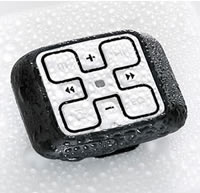 One of our Digital-Lifestyles favorite digital media entrepreneur Swede, Jens Nylander has extracted himself from recent problems and brought out a new mp3 player called MP-X.
One of our Digital-Lifestyles favorite digital media entrepreneur Swede, Jens Nylander has extracted himself from recent problems and brought out a new mp3 player called MP-X.